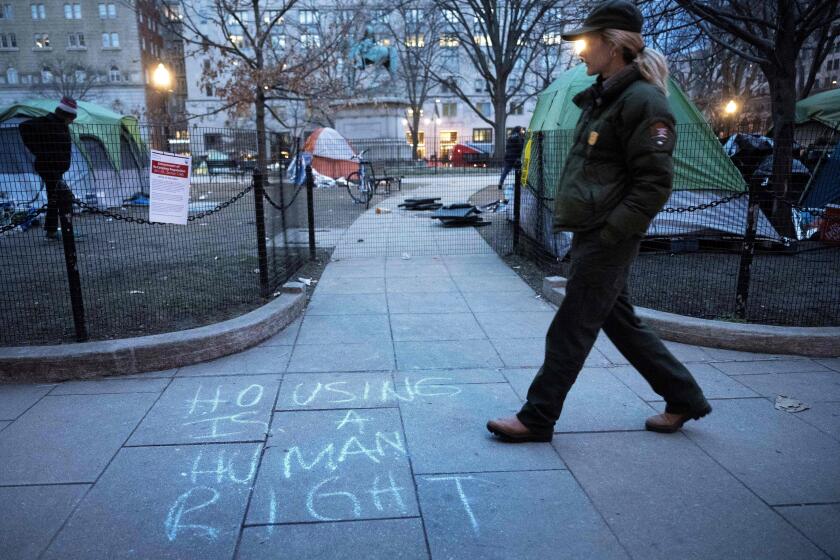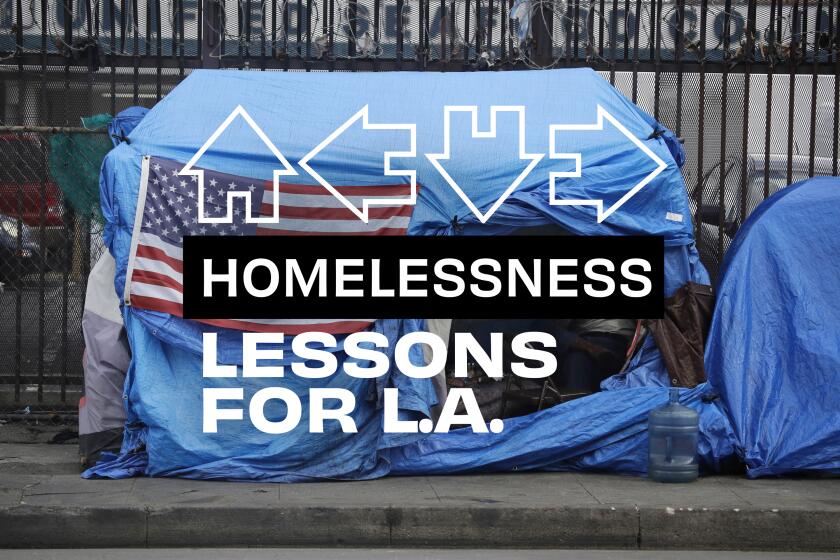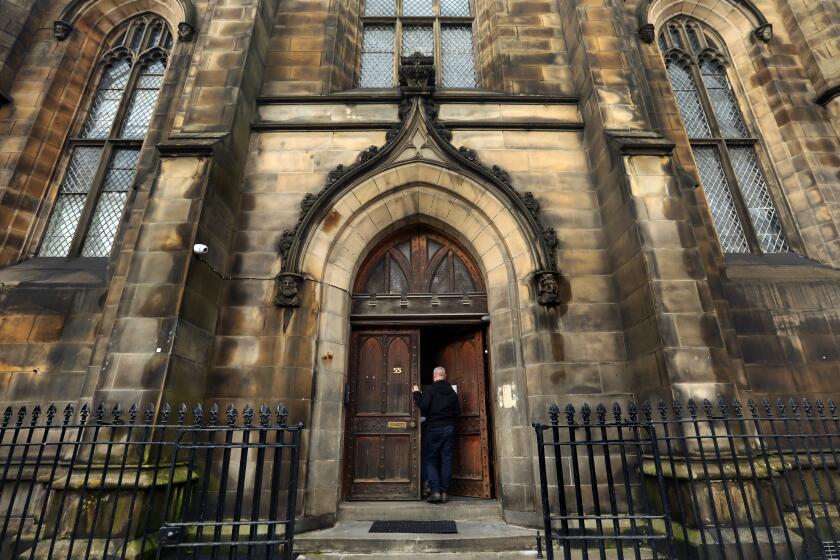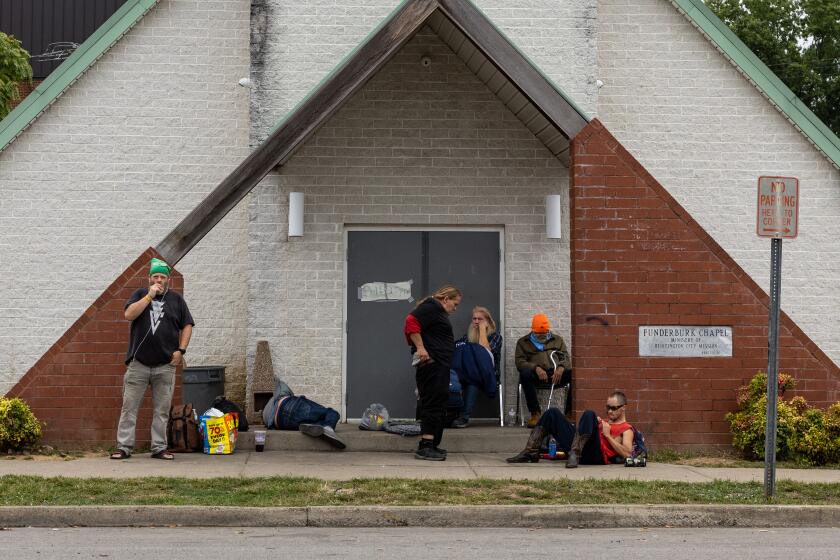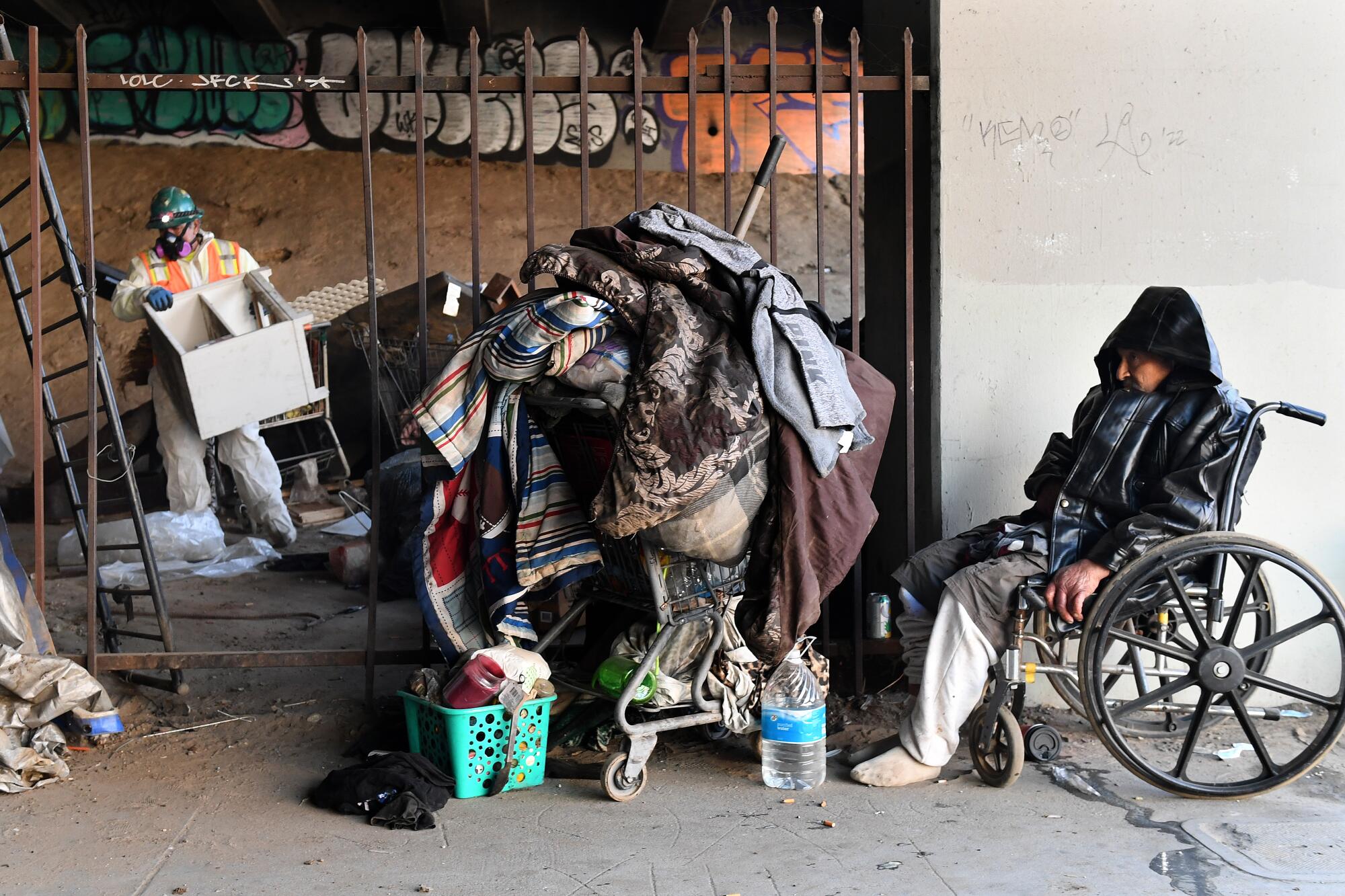
- Share via
WASHINGTON — Blocks from the White House, McPherson Square is a quiet, grassy downtown park where Washingtonians lunch and pigeons perch atop a statue of a Civil War general killed fighting the Confederacy.
A year ago, it became the city’s largest homeless encampment, covered by tents and virtually off-limits to pedestrians.
L.A. and D.C. are both grappling with the homeless crisis. But Washington looks and feels less saturated with homeless people than Los Angeles. Here’s why.
D.C. Mayor Muriel E. Bowser and the National Park Service have strictly enforced laws against camping on sidewalks and in parks. After posting a two-week notice, police fenced off the area and all tents were removed.
Homeless advocates protested and carried signs saying “Shame” and “Stop the evictions.” Two people who refused to leave were handcuffed and taken away. But the fight ended there and today the square remains clear.
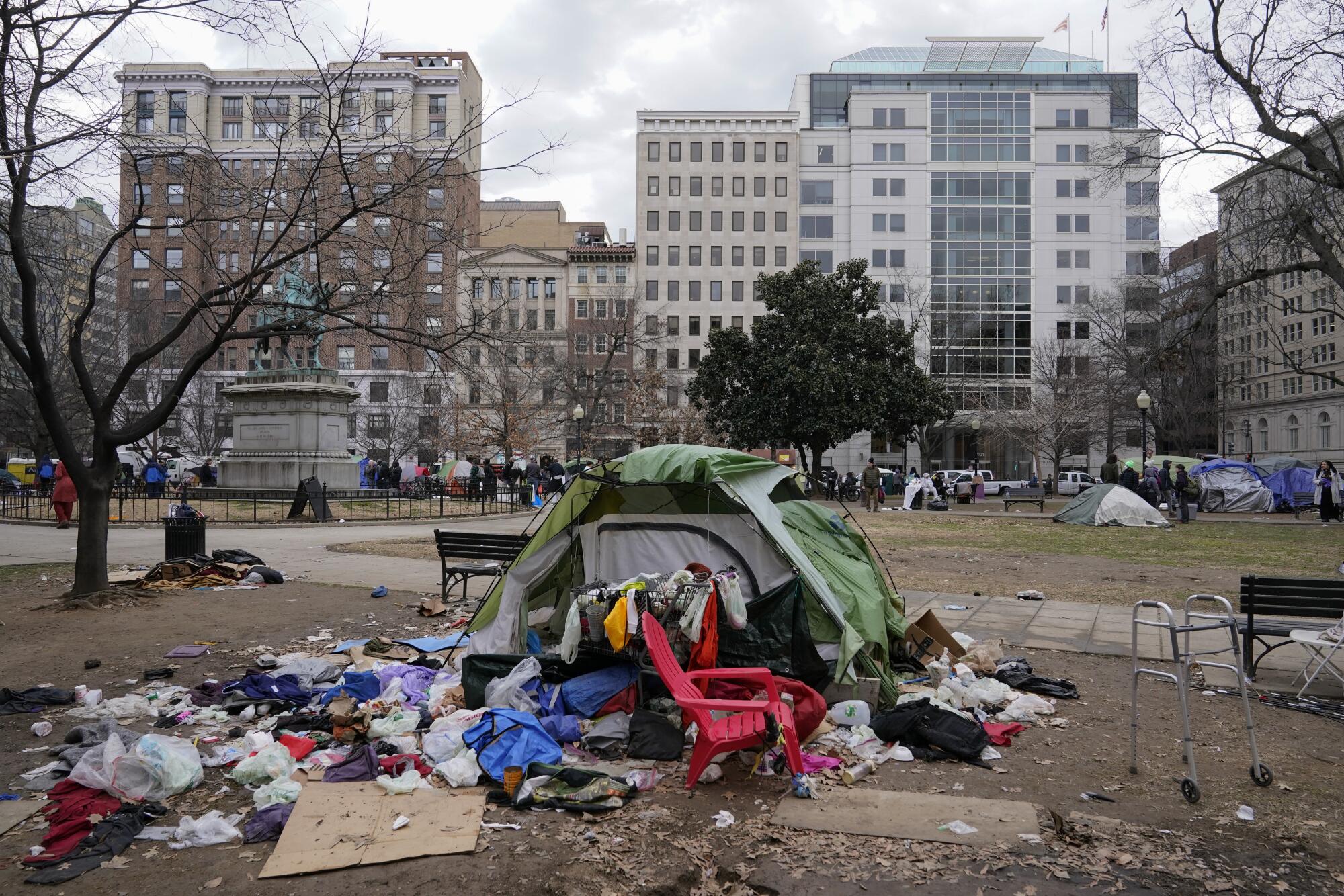
It’s a scene that has played out repeatedly across the country as homeless rates surge and public officials grapple with how to address the housing shortage.
It also illustrates a stark difference in the way anti-camping ordinances are being enforced from city to city and state to state.
In cities such as Washington and much of the rest of the nation, officials are relatively free to enforce local laws to remove homeless encampments.
But thanks to a series of rulings by the 9th Circuit Court of Appeals, public officials in California and eight other Western states face greater scrutiny and legal challenges when they move to clear encampments or relocate homeless people — even when the local laws are virtually the same as those used by cities outside the 9th Circuit.
The appellate decisions established new rights for homeless people who need a place to sleep and limited the authority of police to relocate them.
But no other federal appellate court has followed the 9th Circuit’s legal reasoning and now the decisions are being challenged in the Supreme Court, which could take up the issue early next year.
The first 9th Circuit ruling came in 2006, when judges struck down a Los Angeles sidewalk ordinance and ruled that homeless persons could not be arrested solely because they “lie or sleep” on the streets. Rather than appeal to the Supreme Court, the city settled the case and agreed not to enforce its ordinance during overnight hours.
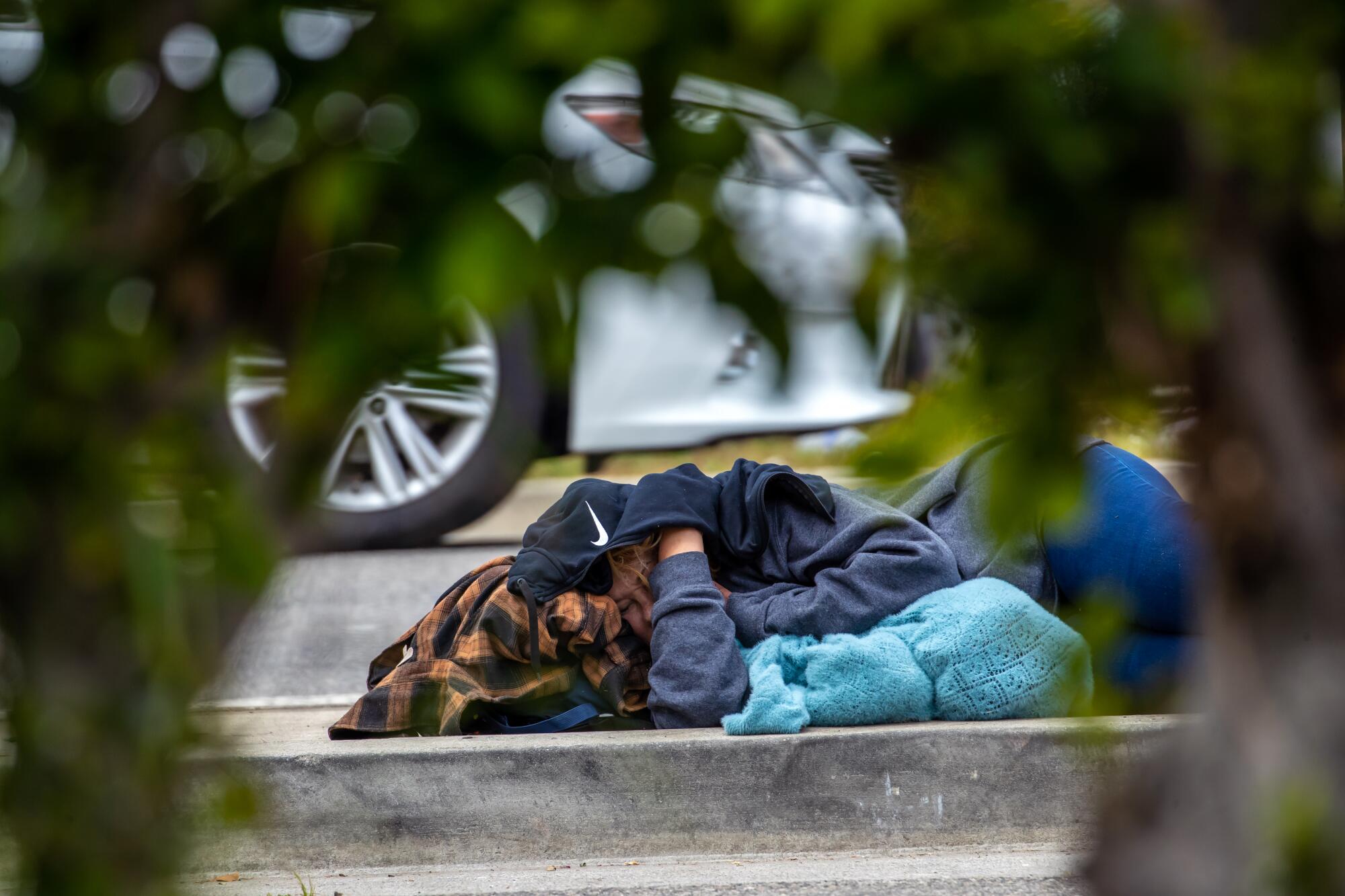
Five years ago, the appeals court ruled it was “cruel and unusual punishment” forbidden under the 8th Amendment to arrest or fine people who were sleeping on the street in Boise, Idaho, because they had nowhere else to go.
In a follow-up ruling last year, the appeals court struck down an anti-camping ordinance in Grants Pass, Ore., because the city did not offer alternative shelter to all those being displaced.
Why is homelessness so much worse in Los Angeles than in other parts of the country, even as other cities also combat poverty, drug addiction and crime?
Together the rulings have created two legal standards for dealing with homeless people and homeless encampments in this country.
“Most local governments throughout the country can remove encampments that are blocking sidewalks and the right of way,” said Amanda Karras, general counsel of the International Municipal Lawyers Assn. But on the West Coast, the 9th Circuit rulings “create a significant amount of uncertainty for local officials over what is legally permissible” when confronting homeless encampments, she said.
To a considerable degree, the rulings “have taken the power to address homelessness out of their hands,” Karras said.
Unlike in Washington, city officials in California know they may face lawsuits for violating the rights of homeless people.
Last December, a federal judge — citing the 9th Circuit — blocked San Francisco’s plan to remove encampments on the sidewalks because the city had not first offered “adequate shelter” to all who were homeless.
The city’s lawyers argued more than half of those living on the sidewalk refused offers of shelter.
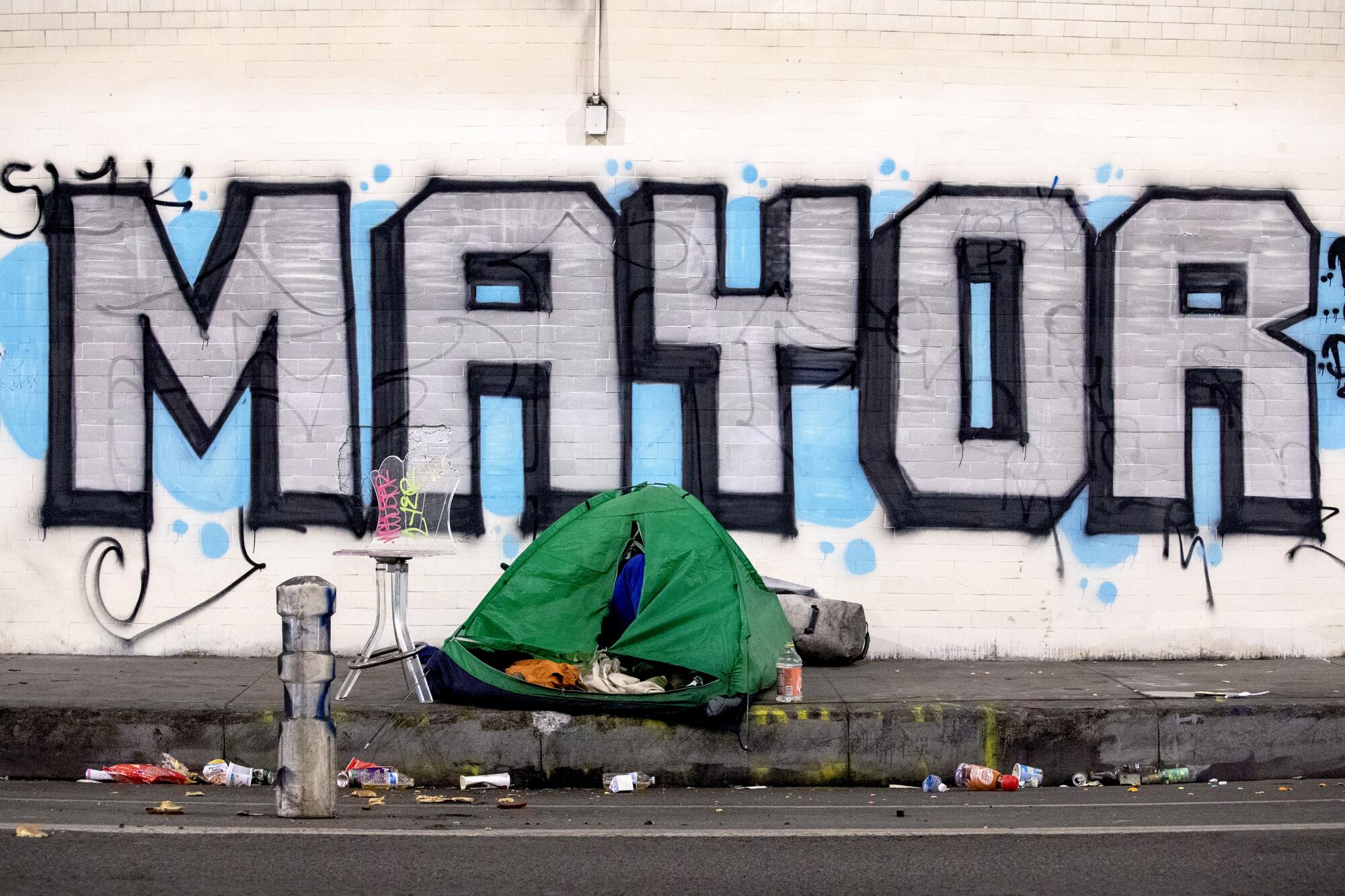
But lawyers say it remains unclear whether the city or police in California may remove an encampment from the sidewalk if a homeless person refuses an offer of shelter.
The city of Los Angeles and California Gov. Gavin Newsom joined two dozen others in September to urge the Supreme Court to hear an appeal of the Grants Pass decision and to clarify the law on sidewalk encampments.
The appeal petition said California is “home to half of the nation’s unsheltered homeless population,” but argued its local officials have less authority than those in most other states.
Los Angeles lawyer Theane Evangelis, who filed the Supreme Court appeal, said homelessness has been made worse by court rulings.
“Los Angeles has been uniquely constrained in its ability to address homelessness” since the settlement of the 2006 ruling on sleeping on sidewalks, she said. The more recent rulings “are now similarly tying the hands of local governments across the Western U.S.”
She pointed out the full 9th Circuit split 14 to 13 on whether to stand behind the decision in the Grants Pass case. The conservative dissenters accused their liberal colleagues of having “paralyzed local communities from addressing the pressing issue of homelessness.”
In a friend-of-the-court brief, Los Angeles City Atty. Hydee Feldstein Soto described the 9th Circuit’s approach as unclear and unworkable.
“Sidewalks currently serve two often incompatible functions: housing tens of thousands of unsheltered residents (and their personal belongings), and also providing access and a right of way for pedestrians, [wheelchair-using] travelers, school children seeking safe passage to and from school, business owners and customers relying on accessible store fronts, and residents seeking to access services from municipal, state, and federal government offices,” she wrote.
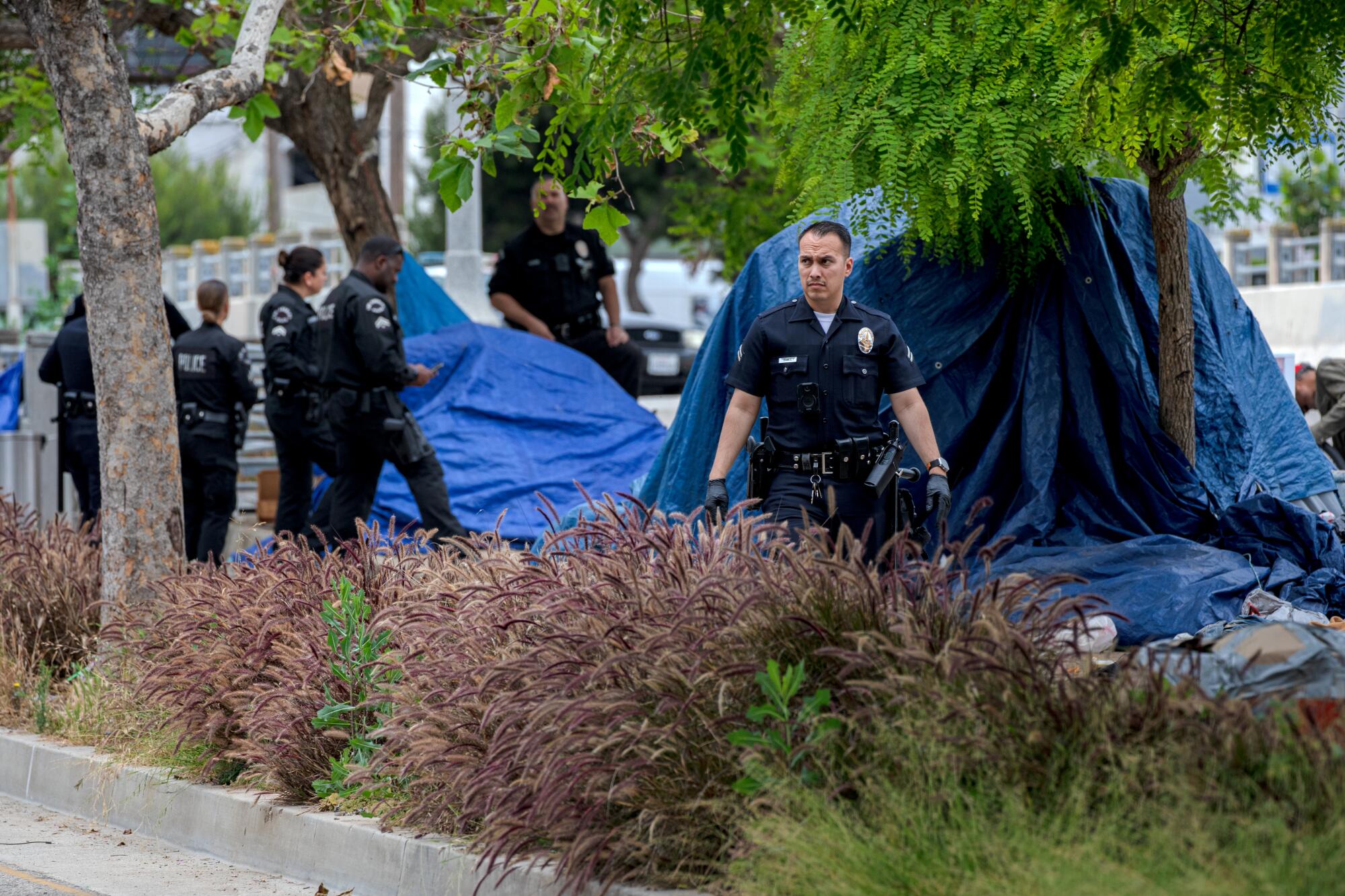
Advocates for homeless people say the impact of the court rulings has been exaggerated.
“It has changed policy to some extent on the West Coast,” said Eric Tars, senior legal policy director with the National Homeless Law Center in Washington and a lawyer supporting the plaintiffs in the Grants Pass case. But “for the greater part, it hasn’t changed policies enough.”
Rather than focusing on the faster and politically expedient route of clearing encampments, cities should be doing the hard work of creating more affordable housing, Tars said.
“They’re complaining more about homeless encampments and that’s provoking an increased law enforcement response,” he said. “Unfortunately, it’s not provoking a housing response, which is actually needed to end homelessness.”
Lawyers affiliated with the Georgetown University Law Center, responding on behalf of homeless people, urged the Supreme Court to deny the challenge to the 9th Circuit’s rulings and accused West Coast political leaders of blaming the courts for their failures.
Many in Los Angeles and California support a legal right to housing. Here’s how that works in Scotland.
“For years, western cities forewent investments in shelter capacity, housing, mental-health services, and addiction treatment, in favor of ‘tolerant containment,’” the Georgetown lawyers wrote on Dec. 6. It will be several weeks before the justices decide whether to hear the appeal.
Despite the rulings, Los Angeles city officials have found alternate ways to deal with the crisis.
Los Angeles Mayor Karen Bass came to office determined to clear street encampments by encouraging people to leave their tents and move into motels and other temporary shelter.
The Times reported recently that she had made significant progress in her first year in office. The city has also stepped up enforcement of a revised ordinance that forbids obstructing sidewalks in many specific places, such as entrances to driveways or freeways, or near schools or day-care centers.
The Department of Housing and Urban Development announced Friday that homelessness nationally has increased to its highest level since at least 2007, when the agency began issuing counts, with an estimated 653,100 people in shelters or streets on a given night in 2023.
For more than three decades, advocates have gone to various state and federal courts seeking protection for impoverished people who live on the street, but they have been unable to duplicate the success they’ve had with the 9th Circuit.
In several cities, including Miami and Dallas, advocates won initial rulings from federal judges in the early 1990s that put limits on the police.
But none of those rulings was upheld in appellate courts. Judges sometimes dismissed the cases for procedural reasons or said they were skeptical of giving special rights to people who were homeless.
“The city is constitutionally allowed to regulate where ‘camping’ occurs,” the 11th Circuit Court said in ruling for Orlando, Fla., in 2000.
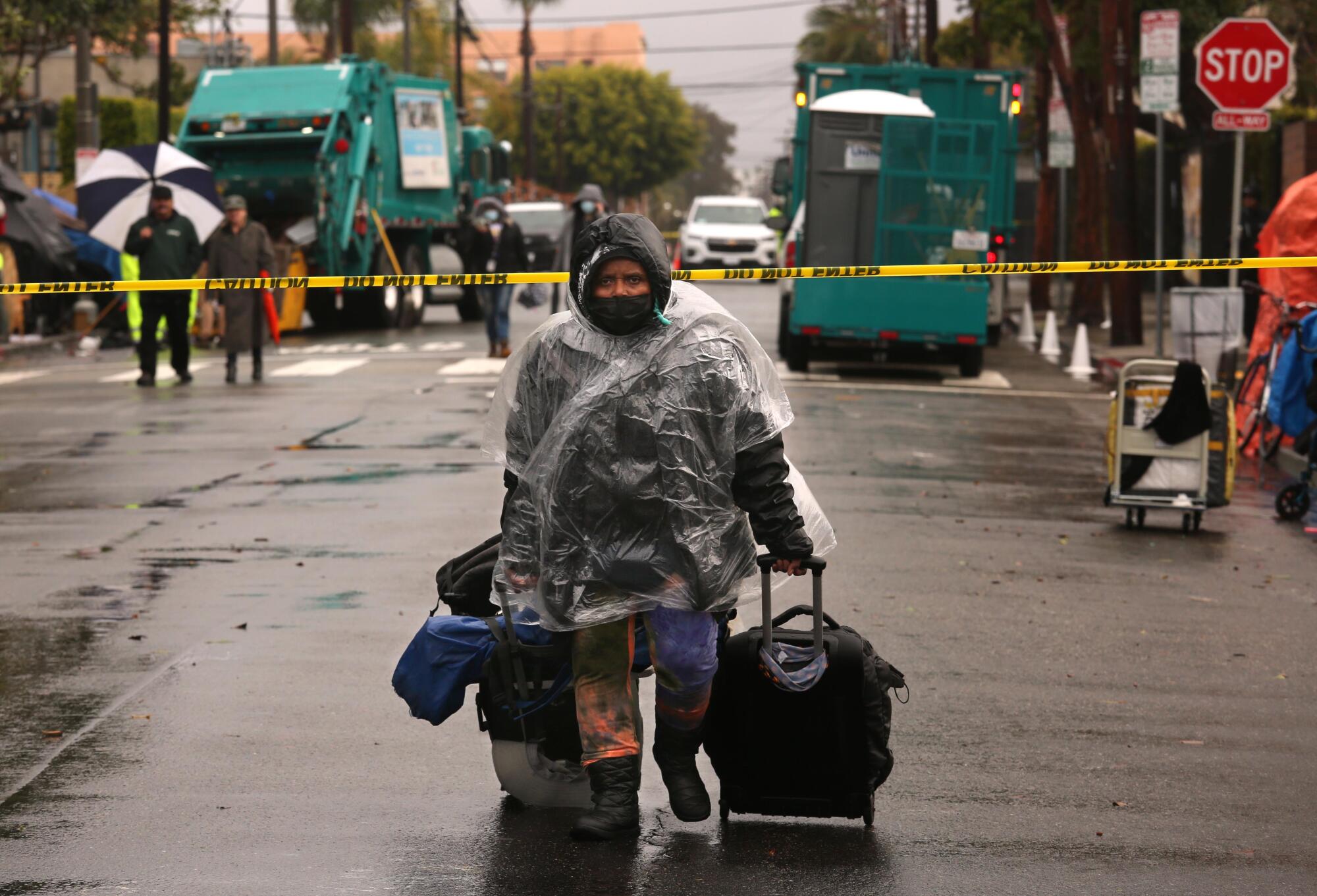
In 1995, the 5th Circuit Court ruled for Dallas and said it would not “weave a new theory” of unconstitutional punishment from the 8th Amendment.
The same pattern held true in state supreme courts. In 1995, the California Supreme Court rejected a challenge to an anti-camping ordinance in Santa Ana that, according to advocates, was intended to banish homeless people from the city.
Ninth Circuit conservative Judge Diarmuid O’Scannlain, dissenting from the recent ruling, wrote last year that “we are the first and only federal circuit to have divined such a strange and sweeping mandate” from the Constitution’s ban on cruel and unusual punishment. “No federal circuit or state supreme court (not one!) has ever embraced Grants Pass’s sweeping holding that the 8th Amendment prohibits enforcement of public-camping restrictions.”
The closest the Supreme Court has come to the issue arose in a case from Lafayette Square, a block from McPherson Square and across the street from the White House.
As winter approached in 1982, the Community for Creative Non-Violence sought a permit for a demonstration that would include a “symbolic tent city” where about 50 people would sleep.
The Park Service approved the permit to demonstrate, but denied permission to sleep in the park. The advocates sued, contending the ban on camping violated the 1st Amendment’s protection for free speech. They lost before a federal judge, won in the U.S. appeals court and finally lost 7 to 2 in the Supreme Court in 1984.
Justice Byron White said the 1st Amendment permits reasonable limits on the “time, place and manner” of demonstrations. “We have very little trouble concluding that the Park Service may prohibit overnight sleeping in the parks involved here,” he wrote.
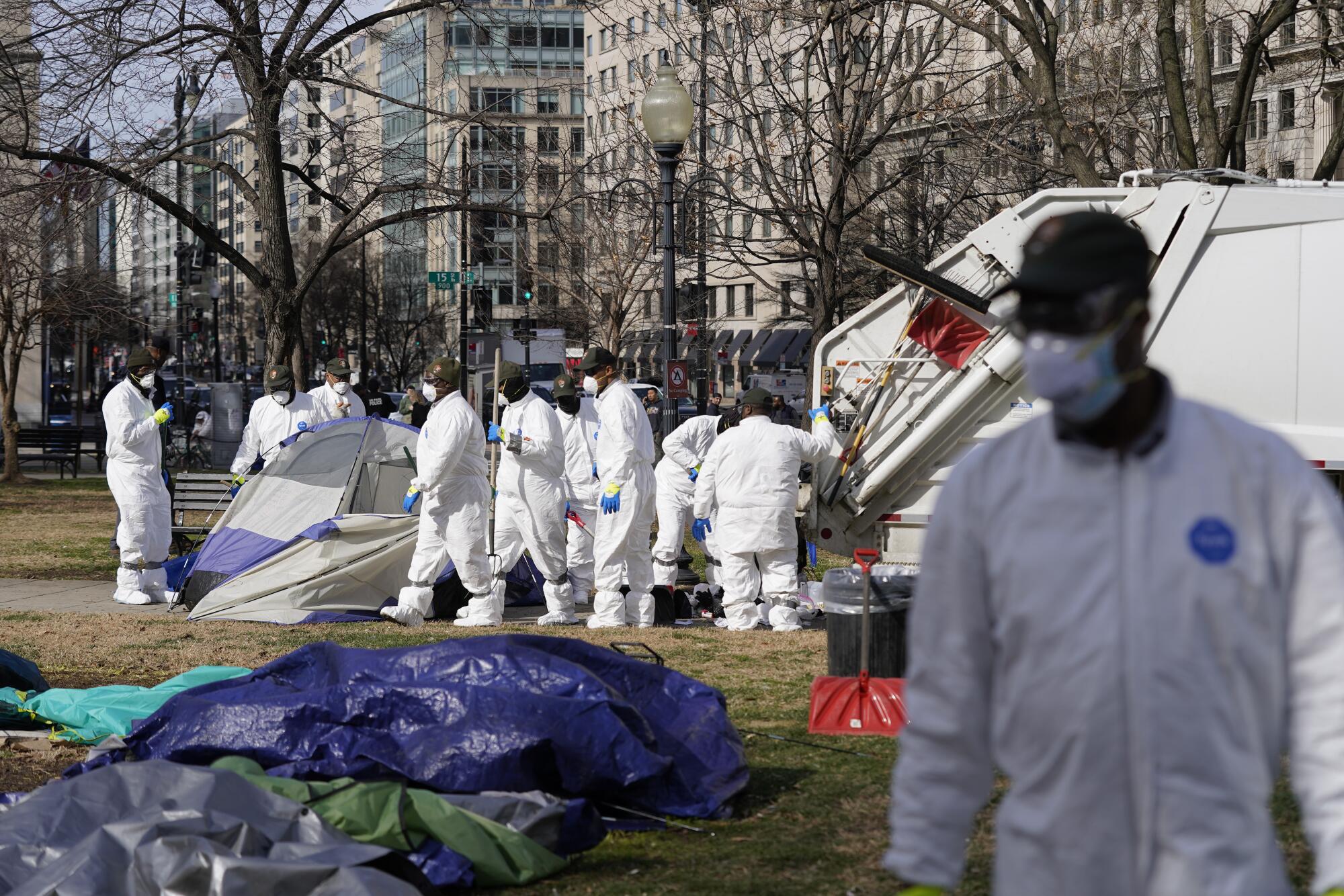
Dissenting, Justices Thurgood Marshall and William Brennan said the tents were a form of symbolic speech that could show the public “in as dramatic way as possible, that homelessness is a widespread problem that confronts its victims with life-threatening deprivations.”
If anything, the law in most places has shifted away from granting rights to unsheltered people, with a judge in Massachusetts allowing the state to place a cap on emergency beds in November under its right-to-shelter law, following an announcement in New York that migrant families would have a 60-day limit in shelters.
The lack of any appellate precedents explains why — when D.C. officials cleared McPherson Square — that was pretty much the end of the story.
To people who believe drug addiction is to blame for L.A.’s tent cities, West Virginia presents a paradox. It leads the U.S. in overdose deaths per capita. But it has a low rate of homelessness.
No one claims that clearing encampments has solved Washington’s homelessness problem. Even proponents of the evictions acknowledge that many people forced to leave simply set up tents elsewhere.
City officials said that of the 47 people who were sleeping at McPherson Square and eligible for housing, most refused the offer.
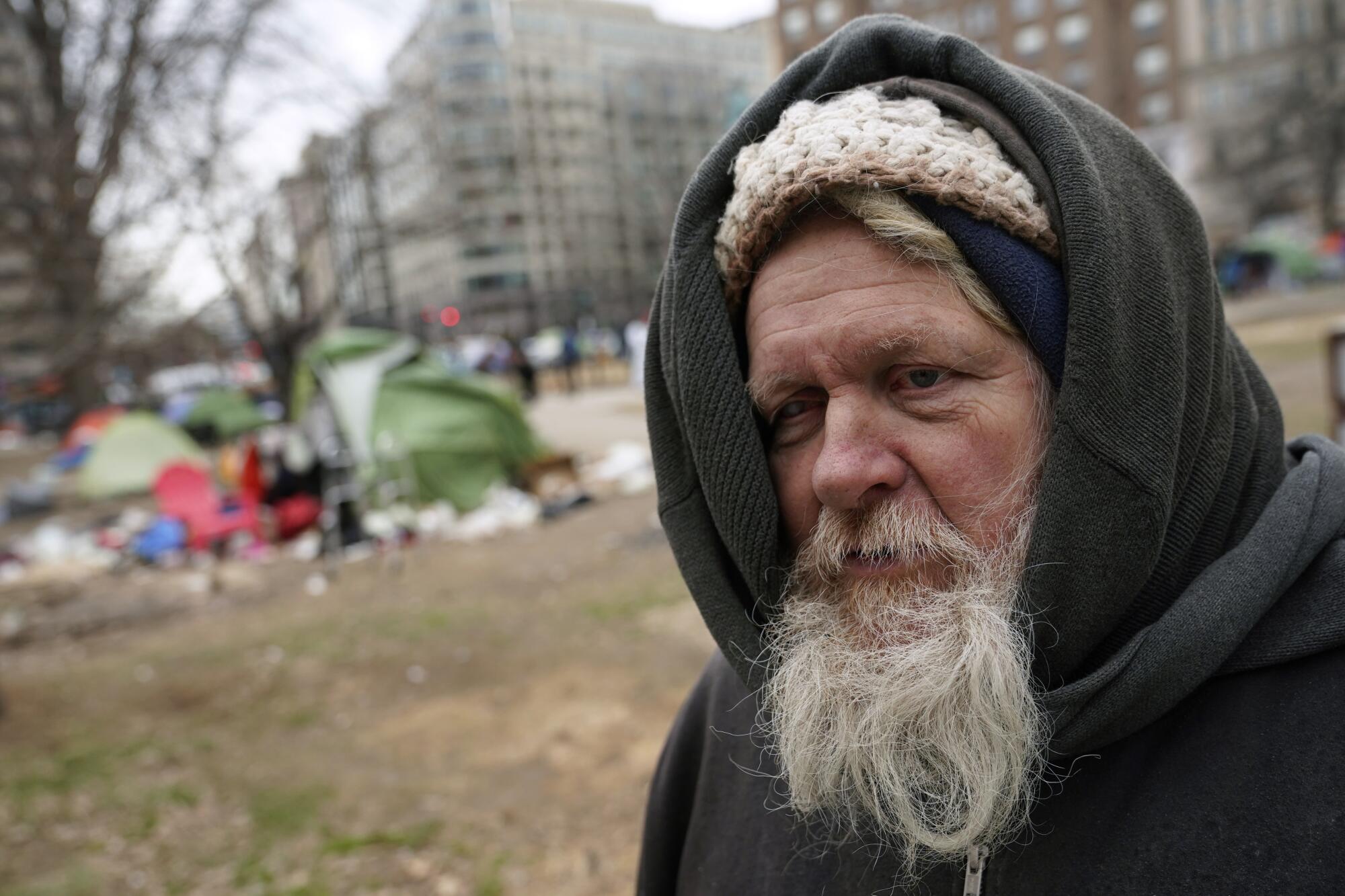
D.C.’s street homeless population, which grew to more than 800 people this year, is about one-seventh that of the city of Los Angeles on a per capita basis.
Tracy Lincoln, 63, was wandering the National Mall with two shopping carts on a recent weekday morning. She said she is one of the few people who has slept among the national monuments, where she has been for more than a year. But she never pitches a tent.
“No, because if you do, they’re gonna remove it,” she said of U.S. Park Police. “You stay out of their way. But if you have a tent, they will see it because they come through on horses. They’re walking. They’re on bikes.”
She said she has also tried to sleep near the Capitol and near the White House, but was kicked out by Capitol Police and the Secret Service, respectively.
“This is the national capital,” she said. “We have people — dignitaries and other politicians from other countries — coming here. They don’t want them to see that. Because you have to remember, the president drives throughout this downtown area.”
More to Read
Sign up for This Evening's Big Stories
Catch up on the day with the 7 biggest L.A. Times stories in your inbox every weekday evening.
You may occasionally receive promotional content from the Los Angeles Times.
